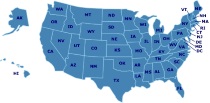Map & Globe Skills
The ability to properly read maps and globes gives you an opportunity to explore different places, people, and cultures in the real world. These resources, teaching tips, and ideas will help make it easy for your children to learn to read and understand maps and globes.
Activities & Experiments
Postcard Kids
Geography Postcard Kids Project started for homeschooled children around the world in October of 2002. It is intended to help enhance geographic studies by sending postcards from their local area to other postcard kids around the world.
Name That Country Game
"Dear Pen Pal, Konnichi wa! We've been to see Mt. Fuji. Name my country! Sayonara, Michiko." Challenge your group with this fast-paced geography game, created in 1992 by Educational Insights, Inc. Everyone begins at the post office. Players twirl a finely printed spinner (built into the game board itself) to select one of 60 countries. If the player can correctly identify the country's location on the board's numbered map, he or she may advance along the path to the finish. Bonus moves are won by landing on "postcard" spaces, listening to the clues on one of the 40 postcards, and correctly identifying the pen pal's country. (The sample postcard above came from Japan.) A more challenging game can be achieved by requiring players to name the country's capital; answers are provided. --Liane Thomas
Great States Board Game
What is the capital of NJ? Where is the Football Hall of Fame? These are just a few of the hundreds of questions players are asked as they adventure around the USA discovering state attractions and landmarks, capitals, state abbreviations, state locations and more. In order to answer the questions on the cards, players must look closely at the colorful USA map game board, becoming familiar with the geography of the country. Players must hurry to find the answers as the mechanical timer ticks. Contents: Game board, 100 Figure cards, 100 Fact cards, 100 Find cards, 1 spinner, 1 mechanical timer, and game rules. Duration of Play: 20 minutes. 2-6 players.
Teaching Tips & Ideas
How I Teach a Large Family in a Relaxed, Classical Way: History
A look at teaching history across several grades using the classical method of education and a rotation of history every four years.
Knowledge Quest
Knowledge Quest offers historical outline maps and timelines designed for the interactive study of world history and geography.
Featured Resources
As an Amazon Associate, we earn from qualifying purchases. We get commissions for purchases made through links on this site.
Climb Inside a Poem for Children Big Book of Poems
The poetry anthology, Climb Inside a Poem: Original Poems for Children, uses the writings of contemporary children's poets, whimsical illustrations, and an expansive big book format (14"x 18") to create a 36-page poetry playground. The children's poems crafted expressly for this collection are written by acclaimed children's authors.
The Mystery of History
The Mystery of History series is another alternative to traditional textbooks. The five volume set covers history from creation to present day, with a biblical worldview. This series is intended for grades K-8. Note that at this time, this series is not completed.
Create! Press
Create! Press carries creative approaches to teaching creative writing and composition. Their products include the Create-A-Story game, Writing Adventures, Stepping Stones, and more.
A Reason For® Reading
A Reason For® Reading offers a series of over 100 Leveled Readers that provide small increases in difficulty from level to level. These colorful books feature Scripture stories and Christian value themes. Story Guides include high-frequency words, teaching ideas, discussion questions, and much more.
In Their Own Way: Discovering and Encouraging Your Child's Multiple Intelligences
Children learn in differing ways. Thomas Armstrong specializes in helping parents identify the unique areas in each of our children that enhance their special way of learning and expressing creativity. This work on multiple intelligences talks about the eight different kinds of multiple intelligences, showing you how to discover your child's particular areas of strength.




